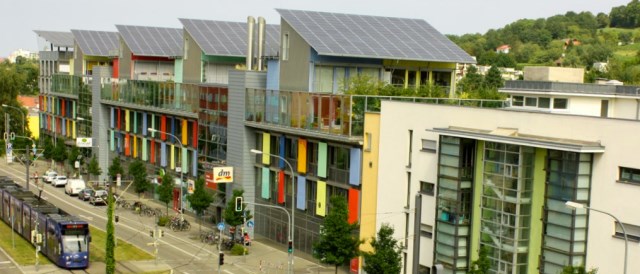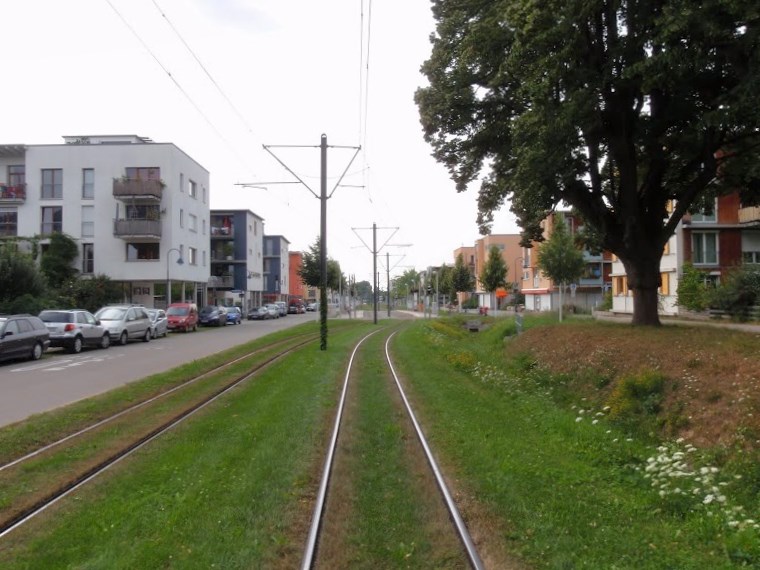American Ozzie Zehner is looking for “alternatives to alternative energy.” Craig Morris agrees with practically everything he says but nonetheless feels that Zehner’s approach is self-serving. Orgs in the US all protect their own industries. Who is left to call for a true energy transition?

The neighborhood of Vauban in Freiburg is a good example for the pervasiveness of environmentalism in Germany. (Photo by s4tomorrow, CC BY-NC 2.0)
Back in 2004, when I was finishing up my German book Zukunftsenergien, a couple of (then) relatively unknown… well, environmentalists, wrote a paper entitled “The death of environmentalism.” They said a few interesting things, but also had little to say about Germany, which was emerging as a leader in renewables at the time. I thought their title was a good trick to get attention – but one that could divide a community that needs to stick together.

Germans would agree with Zehner that consumerism is a problem. By 2050, they aim to reduce total energy consumption by 40 percent – and even then, they will not be 100 percent renewable.
Less than a decade later, Ozzie Zehner is looking for “alternatives to alternative energy.” He has made the press not only in English (“Clean energy’s dirty secrets“), but also in French (“photovoltaics is not that fantastic”) and German (“the solar fairytale”). The media love that angle. He tells of a homebuilder who insisted that two wonderful oak trees be cut down so that his new solar roof would not be shaded. Zehner concludes from the experience that too many people are infatuated with solar.

A view of Freiburg’s Vauban neighborhood, known for its Plus Energy homes, with a decade-old tree on the right. When the neighborhood was developed in the 1990s, none of these historic trees was felled. In Germany, homeowners generally have to get permission from the city before cutting down a tree even in their yard – and the city can turn down the request if the reason is not good. Nonetheless, Germany is a leader in Passive House architecture and solar.
Here, Zehner takes an obviously silly exception in order to divide and conquer – and like the authors of “Death of environmentalism” (and proponents of insulation over photovoltaics), he rebuts claims Germans do not make. He says solar is not what it’s cracked up to be, but who’s doing the cracking? Not the Germans.
Zehner proposes other quite sensible things, such as more cycling and less consumption overall. Germans jibe with all three.
By playing off one thing against the other, you worsen the debate. Laypeople leave with the wrong impression: “see, solar / wind / biomass / whatever isn’t the solution after all.” Of course not – they’re a part of the solution. The solution is a mix of renewables with much lower consumption.
Germans may be leaders in photovoltaics, but they also invented the Passive House concept; nobody insulates better than the Germans (though the Swiss, Austrians, and others do it just as well). And Germany has roughly as much installed wind power capacity as it does solar.
Wanna talk consumerism? Germany is a leader in recycling and a net importer of waste. Cycling? Okay, we’re gonna give that one to the Netherlands and Denmark – but Germany is not far behind.
While some of the brightest young minds in the US boost their careers with headline-grabbing divisive claims, the German renewables community is united and thinks holistically. German wind power association BWE publishes a monthly magazine called “New Energy,” which focuses on whatever is needed, not just wind. Can you imagine AWEA or SEPA regularly writing about the benefits of biomass as the BWE does?
Founded in the 1970s, Germany’s oldest magazine for renewables has a title – Sonne, Wind & Wärme – that can be translated as “solar, wind & heat.” Can you name a single magazine in the US for all renewables? I can only think of British-born Renewable Energy World, which PennWell took over a few years ago. Germany has two, and those are just the big ones.
Germany also has two organizations that represent the renewables sector as a whole: the AEE and the BEE. Their offices are around the corner from each other in Berlin, and they are on friendly terms. Can you name a single nonprofit in the US for all renewables? Maybe it’s time for one – to end the divisiveness. We could start by building up the Renewables100 project.
Craig Morris (@PPchef) is the lead author of German Energy Transition. He directs Petite Planète and writes every workday for Renewables International.
Craig,
The roots of the Passivhaus concepts actually go back to the 70’s work that was funded by the new Department of Energy. One of the early projects that demonstrated the value of air sealing was the Princeton Twin Rivers projects. Work was also progressing in Canada at the Natural Research Council of Canada. In the early 80’s US government research was scaled back by Ronald Reagan. However much the work still continued at many of the northern US states and in Canada. Joe Lstiburek of Building Sciences Corporation has an interesting story about “the old days” and some of the early work. Joe Lstiburek, PhD is also an ASHRAE fellow. In his story of the old days, he has pictures of one of the early houses he built for customers that would have met PassivHaus standards had they existed then.
See: http://www.buildingscience.com/documents/insights/bsi-065-i-was-younger-then?topic=doctypes/insights
I grew up in western Montana and I had seen many houses that were built or being built to the tight standards that nearly ten years later became known as “PassivHaus”.
The works of Prof’s Bo Adamson and Wolfgang Feist are significant – but the concepts that are now the fundamentals of the PassivHaus standards were widely researched and implemented before the first papers were published by Prof Feist. Indeed you may be able to find the early book form of the Princeton Twin Rivers project online in PDF form… all three hundred pages going back to 1976. Blower door testing, thermal bridging, heat recovery ventilators and striving for nearly zero energy use were Princeton goals.
Thanks, Dennis. There is also a great book on solar architecture by John Perlin: http://john-perlin.com/. It goes back much, much longer 😉
Thanks, I’ve seen John Perlin’s book. The one magazine that has covered wind, solar and heat for nearly forty years is “homepower” http://www.homepower.com, but it does not speak for the industry – it is targeted to the residential consumer.
I have relatives that live near Stuttgart and my wife and I have been the host family for a number of German high school exchange students. (Last fall we attended the weddings for one of the students). We’ve been going to Germany for various reasons since 1978 and saw the raise of the Green Party and shift to more active renewable energies. The trip this fall was much longer, as we attended the EU-PVSEC conference in Frankfurt, then the Berlin 2012 conference for climate change at FU, down to Stuttgart for the F-Cell and Storage conference, back to Berlin for IEEE Smart Grid conference, and finally to Freiburg for Solar Summit.
Throughout the years I’ve been taking pictures and tracking the change in energy sources. The change between 2001 and 2010 was quite interesting, but the change between 2010 and 2012 was profound.
One of the major differences between the US and the EU is the emphasis on energy efficiency. In the US most of the focus has been on improving energy efficiency. That has resulted in considerable research, new products, and programs by local, city, state, federal government as well as the utilities to reduce energy consumption. In the north western states (Washington, Oregon, Idaho, Montana), the efficiency improvements have meant that the TWO coal plants are shutting down. Only one nuclear plant remains and we’ve even pulled hydro projects off the rivers.
One of the observations I did make about Germany that has changed since 1978, is the significant increase in window air conditioning, satellite dish, always on consumer electronics, and the increasing size of the kitchen appliances. I’ve seen the same change in the UK and Netherlands. In the US the EIA published an interesting report that looked at the shift in home residential loads — comparing 1993 to 2009.
http://www.eia.gov/todayinenergy/detail.cfm?id=10271
Since 2009, we’ve seen major improvements in nearly all consumer appliances and electronics (world wide). But the improvements are often offset by buying bigger screen TV and larger refrigerators.
[…] yesterday, I published a post at EnergyTransition.de about how frequently American environmentalists try to make headlines by […]